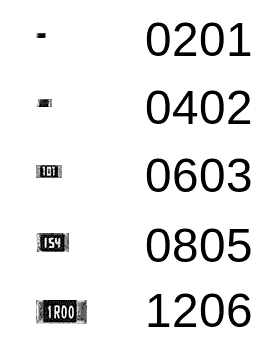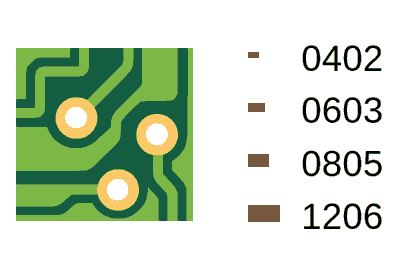We continue with the series of PCB design entries, looking at the sizes and dimensions of the SMD components that we will frequently encounter.
In the previous entry, we saw the usual sizes in PTH components and emphasized the importance of verifying the dimensions before sending a PCB for fabrication.
In the case of SMD, the sizes are much more standardized. This is logical since, in many cases, the assembly of PCBs with SMD components is automated. Therefore, more rigor is necessary than with components placed by hand.
Passive Components
They apply to resistors, coils, and capacitors, and are encoded in standard formats according to the following table

| Code | Length | Width | Power | |
|---|---|---|---|---|
| Imperial | mm | mm | mm | Watt |
| 0201 | 0.6 | 0.3 | 0.25 | 1/20 |
| 0402 | 1.0 | 0.5 | 0.35 | 1/16 |
| 0603 | 1.55 | 0.85 | 0.45 | 1/10 |
| 0805 | 2.0 | 1.2 | 0.45 | 1/8 |
| 1206 | 3.2 | 1.6 | 0.55 | 1/4 |
| 1210 | 3.2 | 2.5 | 0.55 | 1/2 |
Tantalum capacitors have their own dimensions. In any case, or for other types of components, it is best to look at the manufacturer’s datasheet again.
SMD Packages
As for packages for integrated circuits, first, we find the SOD type (Small Outline Diode) for devices with two terminals. For example, SOD123, SOD128, and SOD323 are common.

For devices with three or more terminals, the SOT package (Small-outline transistor) is common. For example, SOT23, SOT232, among others.

Of course, there are many more packages available. It is easy to find the dimensions of these on the internet. But generally, it is easier to start from a component with the same package that we have in the library and duplicate the component from there.
On the other hand, unlike PTH, where library components are very unreliable, in general, SMD library components tend to be more accurate.
However, the recommendation to validate the dimensions of any component that we are going to use, and that we have not created ourselves, remains.
